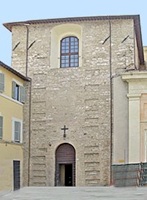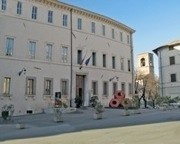This architect from Siena was based in Rome.
Foligno
Remodelling of the Duomo (1703)
In the aftermath of the earthquake of 1703, the restoration of the Duomo began to a plan Sebastiano Cipriani. This was financed by a bequest from on the death of Dionisio Roscioli. The project began in the apse, and involved the closure of its windows after the removal of its stained glass (1485-8). Cipriani’s plans were then abandoned, and work on the remodelling of the rest of the church was delayed for decades.
Design of the Oratorio del Gonfalone (1724)

Spoleto
Palazzo Collicola (1717-30)

This palace belonged to the Collicola family, which had risen to prominence after Taddeo Collicola became the doctor of Pope Urban VIII. Its fortunes blossomed when Francesco Collicola inherited the estate of his rich uncle, Francesco Montioni in 1714. He commissioned Sebastiano Cipriani to design this palace, which was completed in time to host the future King Charles III of Spain in 1734.



